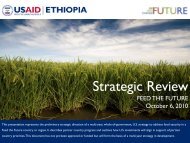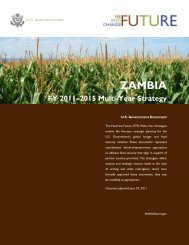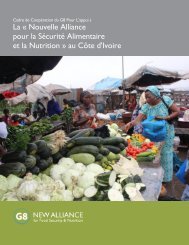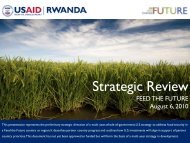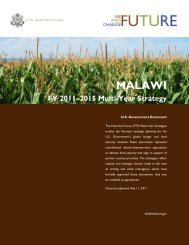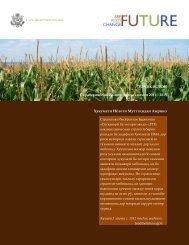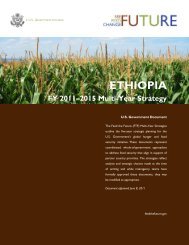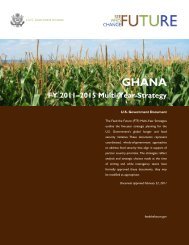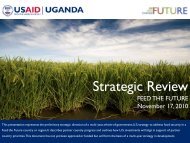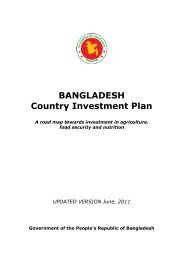Feed the Future FY 2010 Implementation Plan, Tanzania
Feed the Future FY 2010 Implementation Plan, Tanzania
Feed the Future FY 2010 Implementation Plan, Tanzania
- No tags were found...
Create successful ePaper yourself
Turn your PDF publications into a flip-book with our unique Google optimized e-Paper software.
development of <strong>the</strong> <strong>Tanzania</strong> Food andNutrition Center to build integrated nutritionprograms within relevant GOT ministries.PEPFAR also supports national Demographicand Health Surveys (DHS), providing <strong>the</strong>demographic and anthropometric informationused for monitoring <strong>the</strong> nutritional status ofwomen and children. Through PEPFAR andEconomic Growth wrap-around activities, allcurrent activities include economicstreng<strong>the</strong>ning aimed at HIV/AIDS-affectedhouseholds participating in horticulture valuechains, as well as, workplace HIV/AIDSprevention.Women’s advocacy programs and policies arefully integrated within activities, giving woman avoice and rights in <strong>the</strong> agro-processing sectorto ensure <strong>the</strong>ir safety, health and economicsecurity.<strong>FY</strong> <strong>2010</strong> Proposed Actions: Activities willfocus on streng<strong>the</strong>ning local institutions andpolicies to address <strong>the</strong> needs of vulnerablepopulations such as women, children, andpeople affected by HIV/AIDS and <strong>the</strong> very poor.Initially, this will be accomplished through aseries of targeted and/or combined assessmentsfor <strong>the</strong> three value chains being proposed. Wewill also design an impact assessment to becompleted during <strong>the</strong> early stages of <strong>the</strong>program to understand <strong>the</strong> impacts ofagricultural programs on gender assetdistribution and to test assumptions about <strong>the</strong>link between proposed interventions and actualimpacts in reducing malnutrition. Vulnerablepopulations will benefit through partnershipswith PEPFAR and General Mills on foodfortification programs that support a broaderstrategic policy on nutrition enhancement, aswell as scaling up of PEPFAR and EconomicGrowth wrap-around programming.The new Integrated Water, Sanitation andHygiene (iWASH) program focuses onproductive uses of water through <strong>the</strong>development of Multiple Use Services (MUS)and will roll out in <strong>the</strong> target GHFSI regions.The program pays special attention tovulnerable groups and <strong>the</strong>ir participation inMUS to enhance water quality and access, andlivelihoods, which in many cases will includesmall-scale horticulture entrepreneurship. Since<strong>the</strong> horticultural value chain has a high degreeof participation by women, <strong>the</strong>se activities willcontribute significantly to improve nutrition andhousehold income.Nutrition funds will support Vitamin Asupplementation activities that have beeninitiated by <strong>the</strong> Health and Population Office aspart of <strong>the</strong> maternal and child health program.A bond guarantee to a microfinance institutionwill enhance access to credit by at least 200small and medium enterprises.Analytical Work: With Financial CrisisInitiative funds provided through USAID, WFPis undertaking a comprehensive food securityvulnerability mapping assessment that will helpto shape <strong>the</strong> USAID safety net program andinform our understanding of nutritionvulnerabilities in order to develop appropriateinterventions. <strong>FY</strong> <strong>2010</strong> funds will be used byUSAID to assess <strong>the</strong> feasibility of <strong>the</strong> currentfood fortification policy and to make specificrecommendations for creating demand andsupply-side capacity. The program will draw onexpertise to design stand-alone and/orintegrated nutrition programming for <strong>FY</strong> 2011based on an <strong>FY</strong> <strong>2010</strong> assessment of:GOT capacity needs, particularly for interministerialpolicies and programming;GOT assistance needs for supporting <strong>the</strong>CAADP Pillar III to facilitate countrynutrition roundtables and support nutritionadvocacy and inter-sectoral coordination;andKey capacity constraints across a range ofstakeholders for addressing and monitoringnutrition targets.4.1.7. Expand Knowledge and Trainingby Supporting Research andDevelopmentCurrent/Potential USG/Donor Partners:USDA, ASDP Basket (World Bank, Japan, IrishAid, IFAD, AfDB), <strong>the</strong> Gates Foundation19



